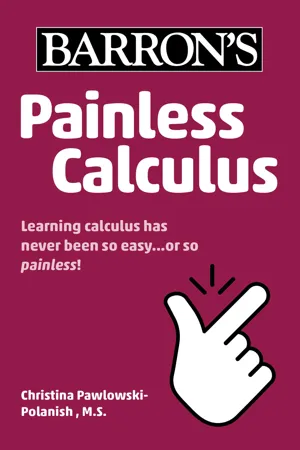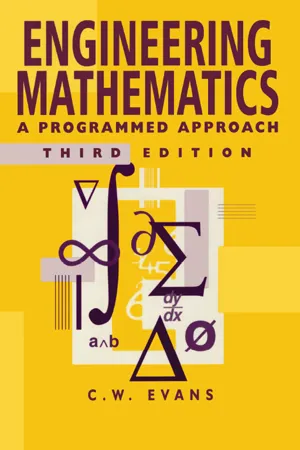Mathematics
Trigonometric Substitution
Trigonometric substitution is a technique used to simplify integrals that involve expressions with radicals. It involves substituting a trigonometric function for the radical expression, which allows the integral to be evaluated using trigonometric identities. This method is particularly useful for integrals involving square roots of quadratic expressions.
Written by Perlego with AI-assistance
Related key terms
Related key terms
1 of 4
Related key terms
1 of 3
3 Key excerpts on "Trigonometric Substitution"
- eBook - ePub
- Christina Pawlowski-Polanish(Author)
- 2021(Publication Date)
- Barrons Educational Services(Publisher)
x):Expand the integrand:Substitute a double angle trigonometric identify for the power of cos(x):Separate the integrals:Now u-substitution can be used for the two trigonometric integrals.Distribute and combine like terms: Integration by Trigonometric SubstitutionsIf an integrand contains radicals of the form , , or , use integration by Trigonometric Substitutions. The goal is to make a substitution for the x-term that will use trigonometric identities to help eliminate the radical.In general if , let x = a sin(θ):By the Pythagorean trigonometric identity, sin2 θ + cos2 θ = 1:Making this substitution rewrites the expression to make it easier to integrate. The table below summarizes the different Trigonometric Substitutions to use for integration. Example 35:Evaluate .Solution:The technique of u-substitution does not apply here since the only expression is in the denominator and its derivative would not substitute anywhere else in the integrand. Since the denominator does not match one of the inverse trigonometric integration formulas, do not use completing the square. Notice that the integrand contains a radical of the form , where a = 2.Using the table, let x = 2sin(θ). This means that x2 = 4sin2 (θ).Differentiate with respect to θ:Substitute into the integral: Simplify the radical in the denominator: Reduce the common factor in the numerator and denominator:The solution is in terms of θ, but the original integral was in terms of x. To rewrite the solution in terms of x, use right triangle trigonometry.Since x = 2sin(θ), then .This ratio can be used to fill in two sides of a right triangle since . When drawing a right triangle, the side opposite to angle θ will be x - eBook - ePub
Engineering Mathematics
A Programmed Approach, 3th Edition
- C W. Evans(Author)
- 2019(Publication Date)
- Routledge(Publisher)
Integration 16 In this chapter we shall extend our table of standard forms still further and learn how to deal with more difficult integrands. After studying this chapter you should be able to □ Use trigonometrical substitutions to resolve algebraic integrands; □ Apply the standard algebraic substitutions to resolve trigonometrical integrands; □ Manipulate integrands and use tables of standard forms to resolve them; □ Assess an integrand to plan a suitable method of integration. At the end of the chapter we consider practical problems in particle dynamics and ballistics. 16.1 INTEGRATION BY SUBSTITUTION Although we have extended our table of standard forms slightly, there are still a few gaps. Three of these are the integrals ∫ √ (1 + x 2) d x ∫ √ (1 − x 2) d x ∫ √ (x 2 − 1) d x We shall now consider how to determine these. To do so we deal further with integration by substitution. Sometimes it is not possible to reduce an integrand to standard forms either by inspection or by the use of partial fractions. In such circumstances a substitution is worth considering. Remember the broad guidelines: 1 Remove denominators; 2 Resolve roots. A good facility with trigonometry and elementary algebra is essential for this. Before going any further it is vital that you are aware of the essential difference in kind between the two integrals ∫ √ (1 + x) d x and ∫ √ (1 + x 2) d x. The first integral can be obtained by inspection. See if you can write the answer down. If we differentiate (1 + x) 3/2 with respect to x we obtain 3 2 (1 + x) 1 / 2 = 3 2 √ (1 + x) so that ∫ √ (1 + x) d x = 2 3 (1 + x) 3 / 2 + C It is unfortunately a common error for students to. write ∫ √ (1 + x 2) d x as 1 3 x (1 + x 2) 3 / 2 + C using broadly the same style of argument. This is incorrect because not constant, so the factor rule cannot be used in this way. Indeed, were we to differentiate this result correctly we should not obtain the integrand. So then we have a problem - eBook - ePub
Elementary Calculus
An Infinitesimal Approach
- H. Jerome Keisler(Author)
- 2013(Publication Date)
- Dover Publications(Publisher)
in Figure 7.6.1. These figures do not have to be memorized. Just remember that the sides must be labeled so that These substitutions frequently give an integral of powers of trigonometric functions discussed in the preceding section. Figure 7.6.1 EXAMPLE 1 Find ∫ (a 2 + x 2) –3/2 dx. Let θ = arctan (x / a). Then from Figure 7.6.2, So EXAMPLE 2 Find. Let θ = arcsec (x / a) (Figure 7.6.3), so So This is as far as we can go on this problem until we find out how to integrate ∫ sec θ d θ in the next chapter. Figure 7.6.2 Figure 7.6.3 EXAMPLE 3. Let θ = arcsin(x / a) (Figure 7.6.4). Then EXAMPLE 4. Put θ = arcsin(x / a) (Figure 7.6.4). Then Figure 7.6.4 Figure 7.6.5 To keep track of a Trigonometric Substitution, it is a good idea to actually draw the triangle and label the sides. EXAMPLE 5 The basic integrals: can be evaluated very easily by a Trigonometric Substitution. Figure 7.6.6 Figure 7.6.7 Figure 7.6.8 Let θ = arcsec x (Figure 7.6.6). Then x = sin θ, dx = cos θ d θ, cos θ. (b) Let θ = arcsec x (Figure 7.6.7). Then x = tan θ, dx = sec 2 θ dθ, sec θ. (c) Let θ = arcsec x (Figure 7.6.8). Then x = sec θ, dx = tan θ sec θ dθ,. It is therefore more important to remember the method of Trigonometric Substitution than to remember the integration formulas (a), (b), (c). PROBLEMS FOR SECTION 7.6 Draw the appropriate triangle and evaluate using Trigonometric Substitutions. 1 2 3 4 5 6 7 8 9 10 11 12 13 14 15 16 17 18 19 20 21 22 23 24 25 26 27 28 29 30 31 32 33 34 35 36 37 Find the surface area generated by rotating the ellipse x 2 + 4 y 2 = 1 about the x -axis. 7.7 POLAR COORDINATES The position of a point in the plane can be described by its distance and direction from the. origin. In measuring direction we take the x -axis as the starting point
Index pages curate the most relevant extracts from our library of academic textbooks. They’ve been created using an in-house natural language model (NLM), each adding context and meaning to key research topics.
Explore more topic indexes
Explore more topic indexes
1 of 6
Explore more topic indexes
1 of 4


